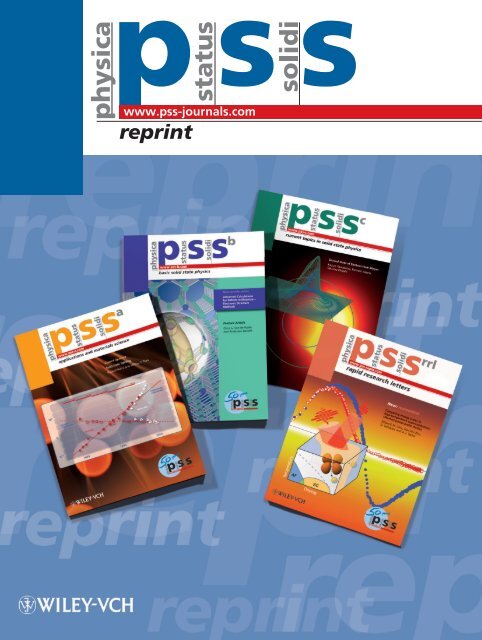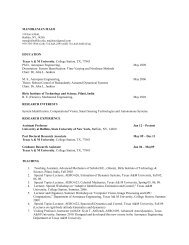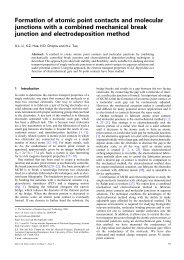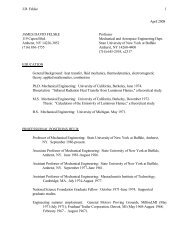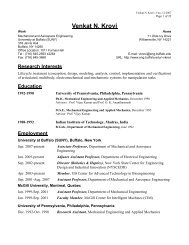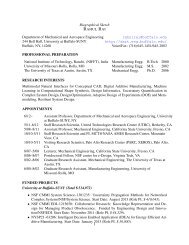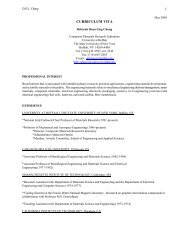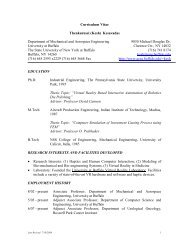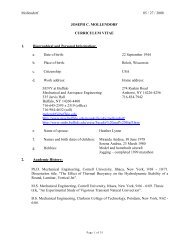physica status solid.. - Mechanical and Aerospace Engineering
physica status solid.. - Mechanical and Aerospace Engineering
physica status solid.. - Mechanical and Aerospace Engineering
You also want an ePaper? Increase the reach of your titles
YUMPU automatically turns print PDFs into web optimized ePapers that Google loves.
eprint
Phys. Status Solidi RRL 6, No. 3, 99–101 (2012) / DOI 10.1002/pssr.201105541<br />
pss<br />
Strength of metals at the Fermi<br />
length scale<br />
www.pss-rapid.com<br />
Jason N. Armstrong, Susan Z. Hua, <strong>and</strong> Harsh Deep Chopra *<br />
Laboratory for Quantum Devices, Materials Program, <strong>Mechanical</strong> <strong>and</strong> <strong>Aerospace</strong> <strong>Engineering</strong> Department,<br />
The State University of New York at Buffalo, Buffalo, NY 14260, USA<br />
Received 21 November 2011, revised 8 December 2011, accepted 12 December 2011<br />
Published online 14 December 2011<br />
Keywords yield strength, Fermi length scale, Sharvin length scale, surface energy, atomic force microscope<br />
* Corresponding author: e-mail hchopra@buffalo.edu, Phone: +1 716 645 1415, Fax: +1 716 645 2883<br />
Using silver <strong>and</strong> gold, we have measured the size-dependence<br />
of the yield strength of atomic-sized samples as small as a<br />
single-atom bridge, with pico-level resolution in the applied<br />
force <strong>and</strong> displacement. The strength approaches theoretical<br />
values as the diameter of the sample becomes comparable to<br />
the Fermi wavelength of electrons (~0.5 nm); in the limit of a<br />
single-atom bridge, the strength is over four orders of magnitude<br />
higher than in bulk single crystals. Results provide direct<br />
evidence for Pauling’s prediction of bond stiffening with reduced<br />
atomic coordination. Beginning with a single-atom<br />
bridge, strength evolves in a staircase manner in Ag, instead<br />
of the intuitively assumed continuous approach to a saturating<br />
bulk value.<br />
Yield Strength (GPa)<br />
150<br />
100<br />
50<br />
t<br />
0<br />
0 1 2 3<br />
Cross-section area (nm 2 )<br />
Measured strength approaching theoretical (ideal) values at<br />
the Fermi length scale, corresponding to a sample made of a<br />
single-atom Au bridge.<br />
t<br />
2a<br />
t t<br />
Strain e ≅a/2a;Idealstrength t= e*E<br />
a<br />
© 2011 WILEY-VCH Verlag GmbH & Co. KGaA, Weinheim<br />
1 Introduction The use of scanning probes to study<br />
atomic-sized samples has led to basic insight into mechanical<br />
forces, quantum properties, <strong>and</strong> their interplay [1–8].<br />
For example, isomorphous Ag <strong>and</strong> Au have nearly identical<br />
bond length <strong>and</strong> lattice constant. Being monovalent,<br />
conductance across a single-atom Au or Ag bridge becomes<br />
indistinguishable, equal to one quantum of conductance,<br />
G 0 = 2e 2 /h. Recent studies reveal new ‘markers’ for<br />
their chemical identity at atomic level based on differences<br />
in the transition from tunneling to contact [8]. As another<br />
example, we have reported a modulus enhancement in Au<br />
at the Fermi length scale [7]. In addition to the modulus,<br />
strength is another property of interest (stress at which material<br />
yields). Here, for the first time, we measure the<br />
strength of metals at the Fermi <strong>and</strong> Sharvin length scales.<br />
2 Experimental details A modified atomic force<br />
microscope (AFM) was used to simultaneously measure<br />
force–deformation <strong>and</strong> conductance traces across atomicsized<br />
samples; the experimental setup is described in detail<br />
elsewhere [6, 7]. Measurements were made at room temperature<br />
in inert atmosphere. The AFM assembly consists<br />
of a dual piezo [6, 7]. With this configuration, the noise<br />
b<strong>and</strong> is 5 pm (peak-to-peak), <strong>and</strong> its center line can be<br />
shifted by a minimum step of 4 pm. Conductance for Ag<br />
<strong>and</strong> Au was recorded at 100 mV <strong>and</strong> 250 mV, respectively.<br />
Increased instability was seen in Ag at higher voltages,<br />
possibly due to electro-migration away from ballistic contacts.<br />
Hence a lower voltage for Ag is used. Piezo was retracted<br />
at a rate of 5 nm/s. Silver <strong>and</strong> gold films (200 nm<br />
thick) were magnetron sputtered (30 W) on Si substrates<br />
<strong>and</strong> cantilevers in Ar atmosphere with partial pressure of<br />
3 mTorr in a UHV chamber with base pressure of ~10 –8 –<br />
10 –9 Torr. The sputtering targets were 99.999% pure.<br />
3 Results <strong>and</strong> discussion Figure 1 shows an example<br />
of simultaneously measured force <strong>and</strong> conductance<br />
across atomic-sized Ag samples, where piezo retraction<br />
© 2011 WILEY-VCH Verlag GmbH & Co. KGaA, Weinheim
<strong>physica</strong><br />
<strong>status</strong><br />
<strong>solid</strong>i<br />
rrl<br />
100 J. N. Armstrong et al.: Strength of metals at the Fermi length scale<br />
200<br />
0<br />
200<br />
Conductance (2e 2 /h)<br />
150<br />
100<br />
50<br />
0<br />
G v<br />
u v w<br />
u v w<br />
F v Yield<br />
8 9 10 11 12<br />
Piezo Retraction (nm)<br />
Figure 1 (online colour at: www.pss-rapid.com) Simultaneously<br />
measured force <strong>and</strong> conductance across atomic-sized Ag bridges.<br />
causes an initially large diameter bridge to be progressively<br />
broken down. Samples from single-atom bridges to<br />
hundred of atoms in diameter were formed. Similar traces<br />
were obtained for Au. Note that while Ref. [9] proves<br />
chain formation using selective examples, over a large<br />
experimental dataset at room temperature, formation of<br />
single-atom bridges instead of chains dominates [6, 7];<br />
chains become prevalent at low temperatures. For a given<br />
atomic configuration, say, ‘v’ in Fig. 1, force increases<br />
(more negative values) until a critical force F Yield is<br />
reached that causes a new configuration ‘w’ to form<br />
abruptly; negative force in Fig. 1 denotes experiments in<br />
retraction.<br />
In Fig. 1, successive atomic configurations (such as the<br />
ones labeled ‘u’, ‘v’, ‘w’, etc.) are separated by a stepwise<br />
change in force <strong>and</strong> conductance. From hundreds of such<br />
traces, F Yield for different sized atomic configurations was<br />
measured; F Yield is the maximum numerical value of force<br />
to break a given configuration. Our analysis used experimental<br />
conductance values to calculate the cross-section<br />
area applying the Sharvin formula, as described previously<br />
[7]. Only in the limit of a single-atom bridge Sharvin<br />
analysis deviates, <strong>and</strong> atomic diameters can be used (also<br />
estimated but not shown). However, this difference is<br />
small (~5%). Thus all the data was base-lined using Sharvin<br />
estimate. In this manner, the size dependence of<br />
strength (force per unit area to rupture) can be determined.<br />
The size dependence of strength of Au <strong>and</strong> Ag is plotted<br />
in Fig. 2(a) <strong>and</strong> (b), respectively. The strength rises<br />
sharply in the limit of a single-atom bridge, <strong>and</strong> approaches<br />
values of ~125 GPa for Au <strong>and</strong> ~14–25 GPa for<br />
Ag. These values are comparable to theoretical values, <strong>and</strong><br />
over four orders of magnitude (10,000 times) higher than<br />
the yield strength of 99.999% annealed single crystals; for<br />
example, the strength of Ag single crystals is ~0.5 MPa<br />
[10]. As an estimate of ideal strength itself, recently, we<br />
have shown that at Fermi length scale <strong>and</strong> beyond (up to<br />
~1.45 nm diameter in the Sharvin regime), deformation occurs<br />
by homogeneous shear instead of defect mediated deformation;<br />
in addition, a large modulus E enhancement of<br />
-10<br />
-20<br />
-30<br />
-40<br />
Force (nN)<br />
Yield Strength (GPa)<br />
Yield Strength (GPa)<br />
150<br />
100<br />
50<br />
1-atom bridge<br />
Au<br />
(a)<br />
0.0 0.5 1.0 1.5 2.0 2.5 3.0 3.5<br />
20<br />
30<br />
1-atom 1-atom<br />
bridge 25<br />
15<br />
10<br />
5<br />
(b)<br />
20<br />
15<br />
10<br />
5<br />
0<br />
Ag<br />
2-atom<br />
4-6 atoms<br />
7-13 atoms<br />
13-19 atoms<br />
0.5 1.0 1.5 2.0 2.5 3.0<br />
0 2 4 6 8 10<br />
Cross-section area (nm 2 )<br />
Figure 2 (online colour at: www.pss-rapid.com) Size dependence<br />
of the strength of (a) Au <strong>and</strong> (b) Ag. Inset in (b) shows a<br />
zoom-in view of strength at the Fermi length scale with data from<br />
additional experiments.<br />
~210–500 GPa was seen (shear modulus of bulk Au being<br />
27 GPa) [7]. As illustrated in the Abstract figure, the ideal<br />
shear strain ε is ~0.5. Taking into account modulus enhancement,<br />
the theoretical shear strength (εE) is ~100–<br />
240 GPa, which is comparable to the experimental value of<br />
~125 GPa in Fig. 2(a). Similarly, using 30 GPa as shear<br />
modulus for bulk Ag, its ideal strength is ~15 GPa. Recently,<br />
we have also measured the modulus of Ag at Fermi<br />
length scale; data shows a smaller modulus enhancement<br />
(~1.5–2 times the bulk value) [11]. Thus the ideal strength<br />
of Ag is ~22–30 GPa, which is the same order of magnitude<br />
as in Fig. 2(b).<br />
As the coordination number of atoms decreases, the radius<br />
of atoms shrinks [12, 13]. Reduction in bond length is<br />
associated with bond stiffening [14], <strong>and</strong> qualitatively explains<br />
the observed strengthening. Higher strength for Au<br />
versus Ag can also be qualitatively explained on the basis<br />
of former’s higher surface energy versus Ag. At these<br />
length scales, surface effects dominate. When the surface<br />
energy is high, more energy is required to form a given<br />
surface. Therefore, higher forces are required to deform<br />
the higher surface energy Au. The Bond–Order–Length–<br />
© 2011 WILEY-VCH Verlag GmbH & Co. KGaA, Weinheim www.pss-rapid.com
Rapid<br />
Research Letter<br />
Phys. Status Solidi RRL 6, No. 3 (2012) 101<br />
Strength framework in Refs. [14, 15] appears well suited to<br />
analyze the size dependence of strength <strong>and</strong> modulus enhancement.<br />
Finally, the inset in Fig. 2(b) shows a zoom-in view of<br />
the strength of Ag, with data from additional experiments.<br />
Remarkably, the data reveals discrete behavior for 1-atom,<br />
<strong>and</strong> 2-atom bridges (st<strong>and</strong>ard deviation of discrete values<br />
shown in blue). The discreteness is due to orientation dependent<br />
variation of the strength because each time a<br />
bridge is formed, forces are measured along different crystallographic<br />
directions relative to the tip <strong>and</strong> the substrate.<br />
This is known from our previous measurements of discrete<br />
atomic displacements [7]. This is followed by plateaus. Although<br />
discrete values were also observed for Au, plateaus<br />
were not seen. This is because the surface energy of Ag<br />
varies little with crystallographic orientation (~6%), in<br />
contrast to ~33% variation for Au [16]. This causes steps<br />
in Au to smear out. Although samples are constrained between<br />
tip <strong>and</strong> substrate, the existence of plateaus is analogous<br />
to the isl<strong>and</strong>s of stability in free clusters; see for example<br />
Ref. [17] for the behavior of clusters with 3–13 atoms.<br />
The position of steps can be qualitatively illustrated<br />
by simple geometric configurations of atoms with increasing<br />
diameter. As shown schematically in Fig. 3, the 1-, 2-,<br />
<strong>and</strong> 3-atom configurations are unique <strong>and</strong> discrete. Once a<br />
3-atom diameter sample is formed, it gives rise to three<br />
equivalent sites, where atoms 4–6 sit (first plateau from<br />
4 atoms to ~6–7 atoms).<br />
1<br />
1<br />
2<br />
1<br />
3<br />
4 5<br />
6<br />
2<br />
1<br />
3 2<br />
4<br />
4 1 5<br />
7’ 3 2<br />
7 6<br />
6-7<br />
5 6 7<br />
4 1 7<br />
3 2<br />
8<br />
13<br />
13<br />
9<br />
12<br />
13<br />
10<br />
11<br />
14<br />
19<br />
19<br />
15 16<br />
4<br />
19<br />
5 6<br />
Figure 3 (online colour at: www.pss-rapid.com) Schematic<br />
showing the atomic configurations to illustrate the occurrence of<br />
plateaus. Arrows <strong>and</strong> numbers indicate available sites; different<br />
colors are used as aid to illustrate the successive build-up of contact<br />
diameter.<br />
3<br />
2<br />
7<br />
18<br />
17<br />
Once the 1 st ring is complete, positions ‘8–13’<br />
(marked by arrows) are filled to give the 2 nd plateau from<br />
7–13 atoms. The 3 rd plateau from 13–19 atoms is associated<br />
with the formation of complete rings around each<br />
atom (marked 2–7 in the 1 st outer ring). Addition of atoms<br />
14–19 results in completion of the 2 nd outer ring for a total<br />
of 19 atoms. Formation of the 2 nd ring creates 12 new<br />
equivalent positions around it, <strong>and</strong> the process continues.<br />
Transitions at diameters with 7 atoms, 19 atoms, <strong>and</strong><br />
37 atoms have been seen in our recent study on the magnitude<br />
of discrete atomic displacements in Au [7]. However,<br />
a large variation in surface energy with orientation in Au<br />
smears out the steps. Even in Ag, the plateaus are highly<br />
susceptible to perturbations. However, Ag provides a new<br />
distinguishing ‘marker’, in addition to the one recently discovered<br />
in Ref. [8]. In summary, the results open the possibility<br />
to impart vastly different strengths based on the<br />
size. Position <strong>and</strong> height of steps can be changed by mixing<br />
elements of different size <strong>and</strong> surface energy, <strong>and</strong> offers<br />
a realistic approach to ‘materials by design’. The results<br />
also provide evolutionary trace of an emergent intensive<br />
property (strength) – variation with size retains the<br />
inherent trait of intensive properties in form of sizeindependent<br />
steps.<br />
Acknowledgements This work was supported by the National<br />
Science Foundation, Grant Nos. DMR-0706074 <strong>and</strong> DMR-<br />
0964830, <strong>and</strong> this support is gratefully acknowledged.<br />
References<br />
[1] U. Dürig, J. K. Gimzewski, <strong>and</strong> D. W. Pohl, Phys. Rev.<br />
Lett. 57, 2403 (1986).<br />
[2] U. Dürig, O. Züger, <strong>and</strong> D. W. Pohl, Phys. Rev. Lett. 65,<br />
349 (1990).<br />
[3] N. Agraït, G. Rubio, <strong>and</strong> S. Vieira, Phys. Rev. Lett. 74,<br />
3995 (1995).<br />
[4] G. Rubio, N. Agraït, <strong>and</strong> S. Vieira, Phys. Rev. Lett. 76,<br />
2302 (1996).<br />
[5] M. Dreher, F. Pauly, J. Heurich, J. C. Cuevas, E. Scheer,<br />
<strong>and</strong> P. Nielaba, Phys. Rev. B 72, 075435 (2005).<br />
[6] J. N. Armstrong, R. M. Schaub, S. Z. Hua, <strong>and</strong> H. D.<br />
Chopra, Phys. Rev. B 82, 195416 (2010).<br />
[7] J. N. Armstrong, S. Z. Hua, <strong>and</strong> H. D. Chopra, Phys. Rev. B<br />
83, 235422 (2011).<br />
[8] J. Kröger, N. Néel, A. Sperl, Y. F. Wang, <strong>and</strong> R. Berndt,<br />
New J. Phys. 11, 125006 (2009).<br />
[9] H. Ohnishi, Y. Kondo, <strong>and</strong> K. Takayanagi, Nature 395, 780<br />
(1998).<br />
[10] T. Imura <strong>and</strong> M. Ishihara, J. Phys. Soc. Jpn. 31, 304 (1971).<br />
[11] J. N. Armstrong, E. M. G<strong>and</strong>e, J. W. Vinti, S. Z. Hua, <strong>and</strong><br />
H. D. Chopra, to be published.<br />
[12] V. M. Goldschmidt, Ber. Dtsch. Chem. Ges. 60, 1270 (1927).<br />
[13] L. Pauling, J. Am. Chem. Soc. 69, 542 (1947).<br />
[14] C. Q. Sun, S. Li, <strong>and</strong> C. M. Li, J. Phys. Chem. B 109, 415<br />
(2004).<br />
[15] C. Q. Sun, Phys. Rev. B 69, 045105 (2004).<br />
[16] L. Vitos, A. V. Ruban, H. L. Skriver, <strong>and</strong> J. Kollár, Surf.<br />
Sci. 411, 186 (1998).<br />
[17] R. D. Etters <strong>and</strong> J. Kaelberer, Phys. Rev. A 11, 1068 (1975).<br />
www.pss-rapid.com<br />
© 2011 WILEY-VCH Verlag GmbH & Co. KGaA, Weinheim


